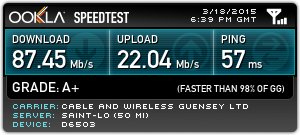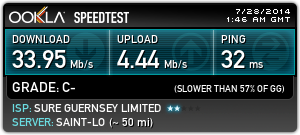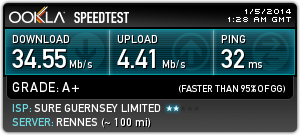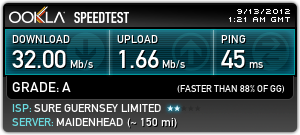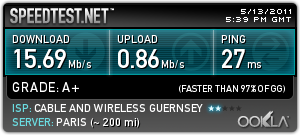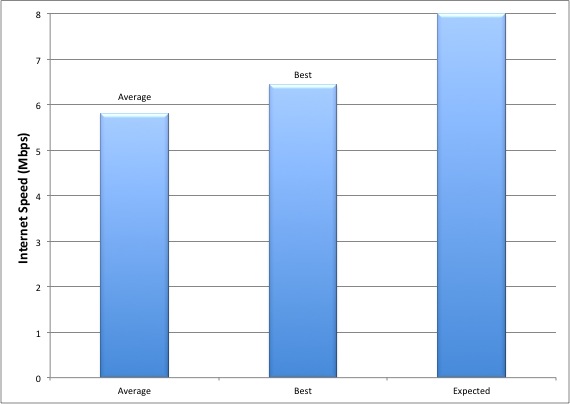4G in Guernsey has finally arrived, with Sure activating 4G around the island dependent on location.
This is of course great news for Guernsey, finally catching up to the UK when it comes to mobile technologies. What surprised me more, was that the initial speediest’s coming in seem to be faster than the ‘average’ UK 4G connection:
I’m not totally up to speed with the LTE ‘categories’ [The different speeds achievable], but it seems that Sure might be using either twice the radio spectrum/bandwidth than many UK carriers, or that their equipment can use more spatial streams (MIMO) than the ‘standard’ amount. They are offering seemingly the ‘up to’ 100Mbps 150Mbps variant rather than the more standard ‘up to’ 50Mbps (resulting in more usual average’s of 30-40 Mbps). Of course as more user’s download on the 4G network, that headline figure will begin to come down, but it’s a very promising start.
Something which is immediately noticeable though, and definitely ‘on theme’ with this blog, is that 4G in guernsey is now at least twice as fast than the fastest fixed line broadband connection that Sure offers on the island. Also, the upload speeds are at least 4x faster than the fastest VDSL connection.
4G data is also priced pretty reasonably: I assume that 4G will be available on the PAYG mobile broadband SIM’s, for which you can buy 50GB of data for £40. I think this is good value compared to the UK, where for example Three offers 1GB for £10. (Meaning 50GB would cost you the equivalent of £500!)
If you compare this cost to fixed line access, which costs £35pm for the 40Mbps service, you might wonder why even bother with having a broadband connection at all! The only reason you might choose VDSL over 4G is if you want truly unlimited data, which I admit is a pretty big deal for some of us (me included!). However for a lot of people, 50GB per month is probably enough, and if you pay just £25 you get 25GB.
So what am I really saying here? Well, there is a disconnect between Sure’s products. If you want the fastest speeds possible, you need to go the 4G route. Not only that, but if you want 4x the upload speeds, you also need to go the 4G route. Uploading a large video to Youtube? Get the 4G dongle out. Backing up your PC files? Yep, 4G dongle again…
It is really time that Sure re-focused on their fixed line product. You might argue that people don’t really need faster than 40Mbps, but then equally do people really need 80+Mbps on their phones? If anything, faster speeds are going to be more beneficial in the home than when you are mobile. Streaming 4K video, more than 1 user at a time, uploading files, cloud access, etc.
At the very least, Sure could split their current VDSL product: 40/10 for home and 80/20 for ‘Pro’, a bit like BT does in the UK. Whilst line length is still of course an issue (and some homes still don’t even have access to VDSL!), it would at least close some of the gap between the blisteringly fast 4G and somewhat slower ‘Superfast broadband’.

